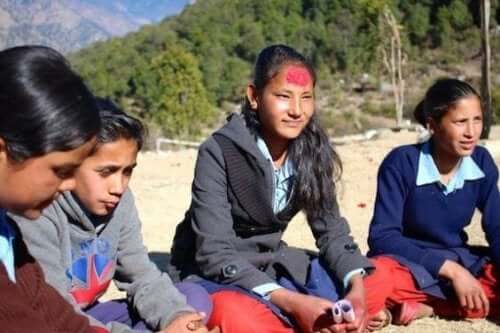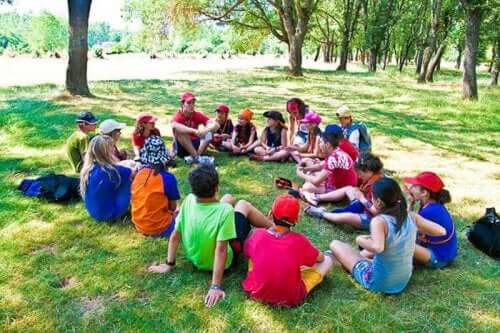Five Activities for Children to Learn about Teamwork

Competitiveness isn’t always positive if it’s not practiced properly. It’s for this reason that different types of values must be reinforced so that our children can learn about teamwork. In this post, we’ll present five fundamental activities that promote it.
Doing activities or jobs individually is important to reinforce the levels of self-reliance and independence that every child needs in the different stages and roles of their life.
However, to achieve a good balance and obtain greater benefits from all the objectives that are set, children need to learn about everything that teamwork involves.
It’s important to bear in mind that no matter the age or responsibilities we have, we’ll always need the help of one or more people around us to achieve some goal or objective. We’re interested in learning about this aspect because we don’t always know how to receive, ask for help, or offer it, and this is what working collaboratively is all about.
Teamwork facilitates communication with peers, integration within society, and collaboration within a community in order to make positive contributions in any area in which our children develop.
The value of teamwork

There are several reasons why collaborative work is necessary, and it’s for this reason that the main benefits of teamwork in achieving successful achievements are highlighted below:
• Reaching a goal “on your own” is satisfactory, but if the effort is made as a team, it can cause a much more significant impact.
• Responsibilities, leadership or hierarchy, and tasks are divided with justice and equity.
• Promotes interaction, a sense of friendship, and constructive conflict resolution.
The purpose of teamwork
The idea of working as a team allows us to enhance, combine, and complement the skills that each one of the members that compose it has for the benefit of all.
That’s why from preschool, people are taught about companionship, respecting ideologies, practicing tolerance, and other similar values.
Teamwork allows you to achieve your goals more quickly, avoiding individual exhaustion and reaching your goals with higher quality.
5 recommended activities

There are different didactic activities that allow you to practice successful teamwork. Professionals such as educators or teachers, psychologists, pedagogues, or elementary characters in the lives of our children (fathers, mothers, and other relatives) tend to use activities for teamwork, such as the following:
1. Contribute at home and at school. Helping to maintain order, decorate, take care of the plants, and distribute the responsibilities that must be carried out in these two places frequented by the little ones.
2. Make shared drawings. This dynamic can make the group reflect on the need for dialogue and communication. It consists of using a blackboard where the first participant will start a drawing. Then, the next classmate continues the drawing and so on until the final result is seen.
3. Communication through the telephone game. This activity consists of a group of people forming a circle in which, one by one, the same information must be whispered in the ear of the following person in a circle. Once the message reaches the last person, they’re responsible for revealing the message that was first communicated.
Generally, the phrase is wrong. So, one of the messages of this collaborative activity is to avoid believing in rumors, as in person-to-person communication, it’s quite likely that the information can be misrepresented.
4. Sports practices. In sports activities, such as volleyball and soccer, among others, teammates must work together. The purpose of this is to unite as a team until reaching the friendly goal of winning.
5. Play “Guess who I am”. Two teams participate in this didactic game and must compete by guessing the mimics of a partner from each team. The first to guess the character in 30 seconds wins a point. In the same way, all members of the group must participate; the first team to reach 15 points wins.
There are different ways in which we can help children to learn about teamwork, be they educational, didactic, sports-related, or fun games. Practicing any of them will be an excellent source of learning about all that collaborative work represents.
Competitiveness isn’t always positive if it’s not practiced properly. It’s for this reason that different types of values must be reinforced so that our children can learn about teamwork. In this post, we’ll present five fundamental activities that promote it.
Doing activities or jobs individually is important to reinforce the levels of self-reliance and independence that every child needs in the different stages and roles of their life.
However, to achieve a good balance and obtain greater benefits from all the objectives that are set, children need to learn about everything that teamwork involves.
It’s important to bear in mind that no matter the age or responsibilities we have, we’ll always need the help of one or more people around us to achieve some goal or objective. We’re interested in learning about this aspect because we don’t always know how to receive, ask for help, or offer it, and this is what working collaboratively is all about.
Teamwork facilitates communication with peers, integration within society, and collaboration within a community in order to make positive contributions in any area in which our children develop.
The value of teamwork

There are several reasons why collaborative work is necessary, and it’s for this reason that the main benefits of teamwork in achieving successful achievements are highlighted below:
• Reaching a goal “on your own” is satisfactory, but if the effort is made as a team, it can cause a much more significant impact.
• Responsibilities, leadership or hierarchy, and tasks are divided with justice and equity.
• Promotes interaction, a sense of friendship, and constructive conflict resolution.
The purpose of teamwork
The idea of working as a team allows us to enhance, combine, and complement the skills that each one of the members that compose it has for the benefit of all.
That’s why from preschool, people are taught about companionship, respecting ideologies, practicing tolerance, and other similar values.
Teamwork allows you to achieve your goals more quickly, avoiding individual exhaustion and reaching your goals with higher quality.
5 recommended activities

There are different didactic activities that allow you to practice successful teamwork. Professionals such as educators or teachers, psychologists, pedagogues, or elementary characters in the lives of our children (fathers, mothers, and other relatives) tend to use activities for teamwork, such as the following:
1. Contribute at home and at school. Helping to maintain order, decorate, take care of the plants, and distribute the responsibilities that must be carried out in these two places frequented by the little ones.
2. Make shared drawings. This dynamic can make the group reflect on the need for dialogue and communication. It consists of using a blackboard where the first participant will start a drawing. Then, the next classmate continues the drawing and so on until the final result is seen.
3. Communication through the telephone game. This activity consists of a group of people forming a circle in which, one by one, the same information must be whispered in the ear of the following person in a circle. Once the message reaches the last person, they’re responsible for revealing the message that was first communicated.
Generally, the phrase is wrong. So, one of the messages of this collaborative activity is to avoid believing in rumors, as in person-to-person communication, it’s quite likely that the information can be misrepresented.
4. Sports practices. In sports activities, such as volleyball and soccer, among others, teammates must work together. The purpose of this is to unite as a team until reaching the friendly goal of winning.
5. Play “Guess who I am”. Two teams participate in this didactic game and must compete by guessing the mimics of a partner from each team. The first to guess the character in 30 seconds wins a point. In the same way, all members of the group must participate; the first team to reach 15 points wins.
There are different ways in which we can help children to learn about teamwork, be they educational, didactic, sports-related, or fun games. Practicing any of them will be an excellent source of learning about all that collaborative work represents.
All cited sources were thoroughly reviewed by our team to ensure their quality, reliability, currency, and validity. The bibliography of this article was considered reliable and of academic or scientific accuracy.
- Cardona, P., & Wilkinson, H. (2006). Trabajo en equipo. IESE Business School, 3, 1-8. https://cmapspublic3.ihmc.us/rid=1H310GC7T-TXLHMH-RC2/El%20Trabajo%20en%20Equipo.pdf
- Díaz, R. M. (2016). Los juegos cooperativos y su incidencia en los estados de ánimo y las emociones en escolares de 10-12 años. EmásF: revista digital de educación física, (41), 108-132. https://dialnet.unirioja.es/servlet/articulo?codigo=5558017
- de León Sánchez, B. (2011, October). La relación familia-escuela y su repercusión en la autonomía y responsabilidad de los niños/as. In XXII Congreso Internacional de la Teoría de la Educación. https://extension.uned.es/archivos_publicos/webex_actividades/5385/repercusiones8.pdf
- Katzenbach, J. R. (2000). El trabajo en equipo: ventajas y dificultades. Ediciones Granica SA.
- Morales, J. E. A., & Vargas, J. E. (2010). Trabajo en equipo. Network de Psicología Organizacional. https://www.procase-elearning.cl/Demos/aau/docs/Trabajo%20en%20Equipo.pdf
- Torrelles Nadal, C., Coiduras Rodríguez, J. L., Isus, S., Carrera, X., París Mañas, G., & Cela, J. M. (2011). Competencia de trabajo en equipo: definición y categorización. Profesorado: revista de currículum y formación del profesorado, 2011, vol. 15, núm. 3, p. 329-344. https://repositori.udl.cat/handle/10459.1/46434
This text is provided for informational purposes only and does not replace consultation with a professional. If in doubt, consult your specialist.








